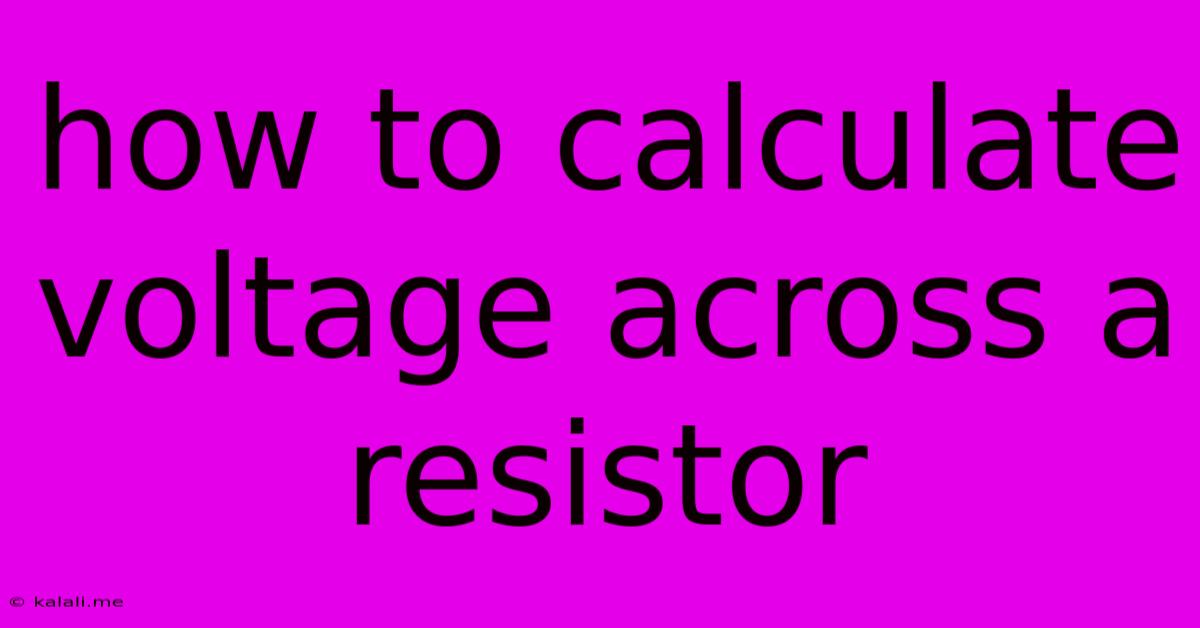How To Calculate Voltage Across A Resistor
Kalali
Jun 06, 2025 · 3 min read

Table of Contents
How to Calculate Voltage Across a Resistor: A Comprehensive Guide
Calculating the voltage across a resistor is a fundamental concept in electronics. Understanding this calculation is crucial for designing, troubleshooting, and analyzing circuits. This guide will walk you through several methods, from simple Ohm's Law applications to more complex scenarios involving multiple resistors. Whether you're a beginner or looking to refresh your knowledge, this article will provide you with the tools and understanding you need.
Understanding Ohm's Law: The Foundation of Voltage Calculation
Ohm's Law is the cornerstone of electrical circuit analysis. It states that the voltage (V) across a resistor is directly proportional to the current (I) flowing through it and its resistance (R). The formula is expressed as:
V = I x R
Where:
- V represents voltage measured in Volts (V)
- I represents current measured in Amperes (A)
- R represents resistance measured in Ohms (Ω)
This simple equation allows you to calculate the voltage across a resistor if you know the current and resistance.
Method 1: Direct Application of Ohm's Law (Single Resistor)
This is the simplest scenario. If you have a single resistor in a circuit and know both the current flowing through it and its resistance, you can directly apply Ohm's Law to calculate the voltage drop across it.
Example:
A resistor with a resistance of 100Ω has a current of 0.5A flowing through it. What is the voltage across the resistor?
Solution:
V = I x R = 0.5A x 100Ω = 50V
The voltage across the resistor is 50V.
Method 2: Using Ohm's Law with Kirchhoff's Voltage Law (KVL) (Series Circuits)
In circuits with multiple resistors connected in series, Kirchhoff's Voltage Law (KVL) states that the sum of the voltage drops across each resistor equals the total voltage supplied by the source. This allows you to calculate the voltage across individual resistors.
Example:
A circuit has a 12V battery and three resistors connected in series: R1 = 20Ω, R2 = 30Ω, and R3 = 50Ω. Calculate the voltage across each resistor.
- Calculate the total resistance: Rtotal = R1 + R2 + R3 = 20Ω + 30Ω + 50Ω = 100Ω
- Calculate the total current: I = V / Rtotal = 12V / 100Ω = 0.12A
- Calculate the voltage across each resistor using Ohm's Law:
- V1 = I x R1 = 0.12A x 20Ω = 2.4V
- V2 = I x R2 = 0.12A x 30Ω = 3.6V
- V3 = I x R3 = 0.12A x 50Ω = 6V
The voltage across R1 is 2.4V, across R2 is 3.6V, and across R3 is 6V. Note that V1 + V2 + V3 = 12V, verifying KVL.
Method 3: Using Voltage Dividers (Series Circuits)
For series circuits, the voltage divider rule provides a quicker way to calculate the voltage across a specific resistor without calculating the total current.
The voltage across a resistor (Vx) in a series circuit is given by:
Vx = (Rx / Rtotal) x Vtotal
Where:
- Vx is the voltage across resistor Rx
- Rx is the resistance of the resistor
- Rtotal is the total resistance of the series circuit
- Vtotal is the total voltage applied to the circuit
Method 4: More Complex Circuits (Parallel and Combined Circuits)
For parallel and more complex combined circuits, you'll need to use a combination of Ohm's Law, Kirchhoff's Laws (both KVL and KCL - Kirchhoff's Current Law), and potentially more advanced circuit analysis techniques like nodal analysis or mesh analysis. These methods are beyond the scope of this introductory guide, but are commonly covered in introductory electronics courses.
Practical Considerations and Troubleshooting
- Accurate measurements: Using a multimeter to measure voltage and resistance is crucial for accurate calculations.
- Tolerance: Resistors have a tolerance range (e.g., ±5%). Account for this when performing calculations.
- Power dissipation: Always check the power rating of your resistors to ensure they won't overheat. Power (P) is calculated using P = I² x R or P = V²/R.
Understanding how to calculate voltage across a resistor is essential for anyone working with electrical circuits. By mastering these methods, you can confidently analyze and design various circuits, from simple to complex. Remember to always double-check your calculations and consider the practical limitations of components.
Latest Posts
Latest Posts
-
How To Steam Tamales Without Steamer
Jun 07, 2025
-
Twitter Website Page Keep Resfreshing Cannot Sign In
Jun 07, 2025
-
Is It Hard To Knock Down Stone Walls Interior
Jun 07, 2025
-
Someone Called Me And Told Me My Check Routing Number
Jun 07, 2025
-
Bathroom Exhaust Fan Not Strong Enough
Jun 07, 2025
Related Post
Thank you for visiting our website which covers about How To Calculate Voltage Across A Resistor . We hope the information provided has been useful to you. Feel free to contact us if you have any questions or need further assistance. See you next time and don't miss to bookmark.